Related Research Articles
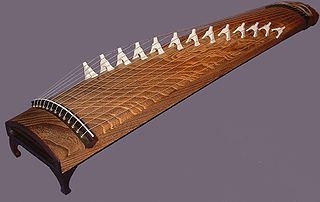
The koto (箏) is a Japanese plucked half-tube zither instrument, and the national instrument of Japan. It is derived from the Chinese zheng and se, and similar to the Mongolian yatga, the Korean gayageum and ajaeng, the Vietnamese đàn tranh, the Sundanese kacapi and the Kazakhstan jetigen. Koto are roughly 180 centimetres (71 in) in length, and made from Paulownia wood. The most common type uses 13 strings strung over movable bridges used for tuning, different pieces possibly requiring different tuning. 17-string koto are also common, and act as bass in ensembles. Koto strings are generally plucked using three fingerpicks, worn on the first three fingers of the right hand.

In music, tape loops are loops of magnetic tape used to create repetitive, rhythmic musical patterns or dense layers of sound when played on a tape recorder. Originating in the 1940s with the work of Pierre Schaeffer, they were used among contemporary composers of 1950s and 1960s, such as Éliane Radigue, Steve Reich, Terry Riley, and Karlheinz Stockhausen, who used them to create phase patterns, rhythms, textures, and timbres. Popular music authors of 1960s and 1970s, particularly in psychedelic, progressive and ambient genres, used tape loops to accompany their music with innovative sound effects. In the 1980s, analog audio and tape loops with it gave way to digital audio and application of computers to generate and process sound.
Electroacoustic music is a genre of Western art music in which composers use technology to manipulate the timbres of acoustic sounds, sometimes by using audio signal processing, such as reverb or harmonizing, on acoustical instruments. It originated around the middle of the 20th century, following the incorporation of electric sound production into compositional practice. The initial developments in electroacoustic music composition to fixed media during the 20th century are associated with the activities of the Groupe de recherches musicales at the ORTF in Paris, the home of musique concrète, the Studio for Electronic Music in Cologne, where the focus was on the composition of elektronische Musik, and the Columbia-Princeton Electronic Music Center in New York City, where tape music, electronic music, and computer music were all explored. Practical electronic music instruments began to appear in the early 1900s.

An album is a collection of audio recordings issued as a collection on compact disc (CD), vinyl, audio tape, or another medium. Albums of recorded sound were developed in the early 20th century as individual 78-rpm records collected in a bound book resembling a photograph album; this format evolved after 1948 into single vinyl LP records played at 33+1⁄3 rpm.
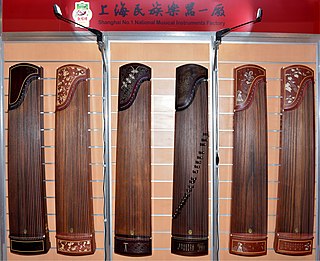
The zheng or guzheng, is a Chinese plucked zither. The modern guzheng commonly has 21, 25 or 26 strings, is 64 inches (1.6 m) long, and is tuned in a major pentatonic scale. It has a large, resonant soundboard made from Paulownia wood. Other components are often made from other woods for structural or decorative reasons. Guzheng players often wear fingerpicks made from materials such as plastic, resin, tortoiseshell, or ivory on one or both hands.
Lycia is an American dark wave band formed in 1988 in Tempe, Arizona. The main personnel of the band are Mike VanPortfleet, Tara VanFlower and David Galas. Although only achieving minor cult success, the band is notable for being one of the ground breaking groups in darkwave and ethereal wave styles. Their 1995 album The Burning Circle and Then Dust received some attention for the power pop hit song "Pray," and the album "remains a high point of American dark rock," according to AllMusic. Lycia's music is characterized by rich soundscapes and layers of echoed guitars, dark and ethereal keyboards, doomy drum machine beats, VanPortfleet's melancholic, whispered vocals and Vanflower's vivid voice. Trent Reznor and Peter Steele are some of their more well-known fans.
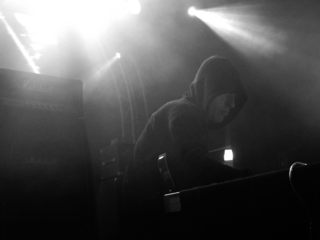
Final is a project of English musician Justin Broadrick, creator of the band Godflesh, which he started when he was just 13 years old. Unlike Godflesh, Final is primarily electronic in nature, taking on a space-like, dark ambient sound.
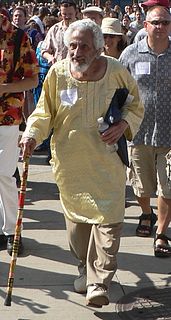
Halim Abdul Messieh El-Dabh was an Egyptian American composer, musician, ethnomusicologist, and educator, who had a career spanning six decades. He is particularly known as an early pioneer of electronic music. In 1944 he composed one of the earliest known works of tape music, or musique concrète. From the late 1950s to early 1960s he produced influential work at the Columbia-Princeton Electronic Music Center.
Tim Perkis is an experimental musician and writer who works with live electronic and computer sound.
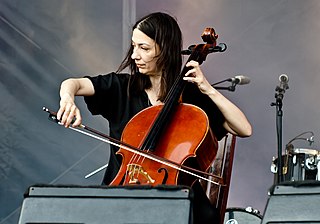
Julia Kent is a Vancouver, British Columbia–born, New York City–based, Canadian cellist and composer. She has performed as a member of Rasputina and with Antony and the Johnsons.
Qubais Reed Ghazala, an American author, photographer, composer, musician and experimental instrument builder, is recognized as the "father of circuit bending," having discovered the technique in 1966, pioneered it, named it, and taught it ever since.
Liang Tsai-Ping was a master of the guzheng, a Chinese traditional zither. He is considered one of the 20th century's most important players and scholars of the instrument. He also played and taught the guqin.

Doug Gillard is an American guitarist and songwriter. He has been a member of major indie pop and punk bands, most notably Guided by Voices, Nada Surf, Bambi Kino, Death of Samantha, and Cobra Verde.
Dow Jones and the Industrials were a new wave band from West Lafayette, Indiana from 1979 until 1981. During this time, they released a split LP with The Gizmos, entitled "Hoosier Hysteria", and a self-titled 7" EP, both released in the year 1980 alone. A track of theirs, "Ladies With Appliances", was also featured on the "Red Snerts" compilation.

Pamela Z is an American composer, performer, and media artist who is best known for her solo works for voice with electronic processing. In performance, she combines various vocal sounds including operatic bel canto, experimental extended techniques and spoken word, with samples and sounds generated by manipulating found objects. Z's musical aesthetic is one of sonic accretion, and she typically processes her voice in real time through the software program Max on a MacBook Pro as a means of layering, looping, and altering her live vocal sound. Her performance work often includes video projections and special controllers with sensors that allow her to use physical gestures to manipulate the sound and projected media.

Hans Reichel was a German improvisational guitarist, experimental luthier, inventor, and type designer.
The Club Foot Orchestra is a multi-faceted musical ensemble whose live performances of modern scores for silent film sparked a revival in the genre that continues today. Their innovative style creates a musical atmosphere that brings silent film into the modern era, synthesizing sounds of Eastern European music, Impressionism, and Jazz Fusion. The New Yorker said "This is music that bubbles up from the intersection of aesthetics and the id," They have performed at Lincoln Center, Symphony Space, The Smithsonian, World Financial Center, SF Jazz, and their home at the Castro Theater in San Francisco, among many other venues in the US, Mexico, and Canada.
Brad Laner is an American musician and record producer best known for his work with the shoegaze band Medicine, which he founded and led.
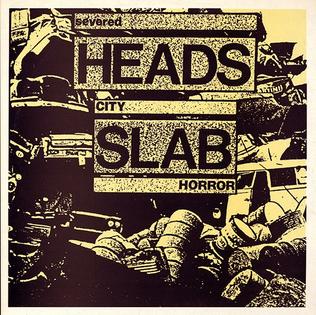
City Slab Horror is the fifth studio album by the Australian experimental pop music group Severed Heads. First released in 1985 through Ink Records, it is the second major label album the group has ever released, following the 1983 album Since the Accident. The track "Goodbye Tonsils" was released as a single to promote the album, which met favorable reviews from some critics and no reviews at all from the vast majority of the remaining critics.

Michael Szewczyk, known as DJ Textbeak, is an American DJ, artist and record producer.
References
- ↑ "Archived copy". Archived from the original on 2008-08-20. Retrieved 2008-12-31.CS1 maint: discouraged parameter (link) CS1 maint: archived copy as title (link)
- ↑ "Locals Only: Not Pointless Anymore: Mike Hovancsek Launches A New Label With The Release Of His Solo Debut," by Anastasia Pantsios . Cleveland Scene, v. 11, no. 37 (January 7, 2004). [ permanent dead link ]